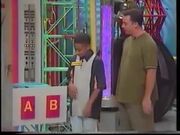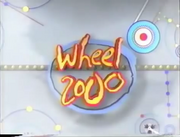
Wheel of Fortune 2000 (almost always shortened to Wheel 2000) was a children's version of Wheel of Fortune created and produced by Scott Sternberg which ran concurrently in first-run on CBS and GSN from September 13, 1997 to February 7, 1998. It was hosted by David Sidoni, with Tanika Ray as the voice of CGI announcer/hostess "Cyber Lucy". James Marcione served as director, with Pamela Covais as producer.
The show was consistently #1 among CBS' children's programming that season (unsurprising, given its pedigree), but finished its first-run episodes in 46th place with approximately 350,000 Kids 2-11 viewers and a 0.9 rating; on average, the network's Saturday-morning lineup as a whole continually ran a distant fourth, with a 0.5 rating (about 190,000 Kids 2-11 viewers).
While Wheel 2000 is a footnote of the American franchise and one of the briefest Wheel adaptations in the world, it was adapted for Turkey (as Cark 2000) in 2000 and Vietnam (as Chiếc nón kỳ diệu) from at least 2007-09.
In more recent years, the show has been criticized by fans in many facets, such as the noticeably lower budget and the fact that several longstanding rules were altered to make the game harder for this version's players.
Changes[]
- Wheel 2000 airs weekly, on Saturday mornings. The official timeslot is 11:30 AM Eastern/Pacific, although some of those affiliates air it earlier and others air it on Sundays.
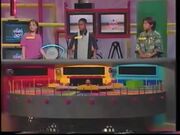
- A much smaller set is used, despite taping in Studio 11 at Sony Pictures in Culver City (the same studio as the adult version). The only holdovers from the adult version are the score displays and flippers. A large colored light bulb is at the left side of each display.
- Children aged 10-15 play for points (not cash) and prizes more geared towards that age group, with no returning champions. Despite this, the show's current policies count this version as your once-in-a-lifetime appearance on the American franchise.
- The opening spiel is "Hey, it's time to play...Wheel 2000! And here's our host: David Sidoni!"
- The intro begins with a CGI factory (including representations of various set pieces) producing letters and numbers of the show's logo; the letters are pushed into a tunnel, landing at the bottom to form the Wheel of Fortune 2000 logo.
- As Lucy says "Hey, it's time to play...", a puff of smoke appears, changing the full title to the shortened one just before the audience chants the title. After this, another puff of smoke appears as the transition to the set.
- Following David's introduction, he then introduces Lucy.
- The show's full title is only used in the opening, on the Prize Box, and on a small set piece between the red and yellow contestants.
- The Wheel is very different and, as a result of not using money, is the cheapest of the American franchise:

Wheel! Of! Points!
- Top point values are 1,000 in Round 1, 2,000 in Round 2, and 5,000 thereafter. This is the first appearance of 2,000 since 1989. Other than this and the stunts, the Wheel uses a single template.

The mysterious Creature.
- Bankrupt and Lose a Turn are replaced by The Creature and Loser, respectively. The "Creature" is a monster (possibly a dragon) that lives beneath the Wheel and comes up to "eat" the player's points, with a graphic of electrical bolts "shocking" the score display.
- Free Spin is removed entirely.
- New special spaces are added: Double Up, www.Wheel2000.com, and various physical games that change from episode to episode.
- The Prize Wedge is replaced with the Prize Box.
- The center of the Wheel has a monitor on it, which typically shows the Wheel 2000 logo. Lucy sometimes appears on this screen, reminiscent of the chroma-key closing shot used in the 1970s-80s.
- The layout, going clockwise from The Creature, is Creature-650-Stunt (250)-400-600-Prize Box (100)-550-Loser-350-Stunt (250)-500-300-150-Website (750)-450-(Top Value)-Stunt (250)-700-250-Double Up (500 or 1,000)-200. This is the first appearance of 100 since 1991; the first of 150, 200, and 750 since 1996; and the first of 650 since 1979.
- Instead of equal-sized pegs, the Wheel has tall pegs at the edge of each wedge with two shorter ones in between, a trait shared by several international versions (including Germany). The tall pegs are yellow, while the short ones are red.
- All of the sound effects and music are changed:
- The show has an original opening and closing theme composed by Dan Sawyer.
- During main game rounds, correct letters are revealed by an electronic male voice saying the letter (and repeating for every occurrence as needed). This voice is believed to be the "Fred" setting on Apple Computer's MacinTalk voice synthesis program.
- The "wrong letter" buzzer is a deeper and more dissonant sounding one.
- When the Creature is hit, deep laughter and an electronic downward glissando are heard.
- During the Bonus Round, letters reveal with an electronic "booping" sound. The timer is a new tick-tock sound with a loud buzzer at the end.
- The Final Spin bells are replaced by a steam whistle previously used on Sternberg's Let's Go Back.
- New sounds are added for Loser, the Prize Box (later used on the 2002-04 Pyramid), the top value, www.Wheel2000.com, Double Up, and the various stunts; a light sound for when the clock/randomizer appear just before the stunt; a bell clang for earning a letter in the stunts; a "time's up" foghorn for games that end without a Speed-Up; and a series of noises for winning the Bonus Round. At least some of these were also used on Zooventure.
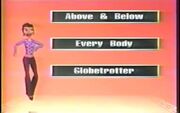
- Only three categories are held over, albeit with different names: Place becomes "Globetrotter", Proper Name becomes "V.I.P.'s", and Thing becomes "Just Stuff" (it is not certain whether "Monumental" was a holdover of Landmark); all others are unique. The contestant who starts the round picks one of three categories; Lucy shows the categories at the start of each round, which slide onscreen with a "whoosh" sound effect, and a new set is given for each round. The category display is above the puzzle, but not present during Speed-Up rounds.
- The board is replaced with a monitor.
- Blank spaces are gray and turn white when a letter is revealed. The category appears at the top of the monitor in white on a black striped background. Lucy is usually shown to the viewer's left, but sometimes changes position.
- While there is no visibly-defined "limit" for the puzzle board (only the necessary spaces are shown), puzzles are nonetheless aligned as they would be on the adult boards. This and the below suggest a four-line board with ten spaces per row (40 spaces total), slightly smaller than the 1974-81 board. The letters are in the Atrox font.
- No puzzle is known to have used more than three rows, the longest known being LUDWIG VAN BEETHOVEN (V.I.P.'s) at 18 letters; conversely, the shortest known puzzles are SPAIN (Place) and ORBIT (Space Case). Bonus puzzles are placed on a separate "line" just below the category title, a top row that appears to be exclusively used for this purpose.
- When David explains each special space, the camera does a spinning zoom-in on that space.
- Contestants who try to solve a puzzle are shown in the lower right-hand corner much like the Bonus Round; solving a puzzle awards a prize, which is kept regardless of the game's outcome.
- The "house minimum" for solving a puzzle is 500 points, but only if a player solves for less than 250, a rule that is known to have affected the outcome at least once.
- After a main-game puzzle is solved, the subject is explained in detail by Lucy, an actor (not necessarily of a CBS show), or an athlete.
- If the Final Spin lands on a special space that is not a penalty (Physical Game, Prize Box, Double Up, etc.), each consonant is worth the space's face value.
- The procedure for handling "only vowels remain" in the Speed-Up round varies, but in both known cases is not done until after the turn in which the last remaining consonant is called.
- In the case of a tie (which is known to have happened at least once), a tie-breaker round is played. Presumably due to the game being played for points, the Wheel is not spun and consonants are worth 5,000 points.

- The Bonus Round uses the nighttime "pick an envelope" format, albeit with just two choices (A-B) much like the British version; bonus puzzles are always a straightforward Person, Place, or Thing.
- As usual, RSTLNE is provided at the outset, followed by three more consonants and a vowel from the contestant. Unlike on the adult version (yet like on some international versions), accidentally picking any of RSTLNE as one of the contestant's three-and-a-vowel is treated as a wasted pick.
- The A-B envelopes are red with a large yellow letter (changed to yellow with red letters in later tapings) on the front, while prize names are printed in small, black all-caps Times New Roman font on a white background. Against precedent, the bonus prize is only revealed if the contestant solves the puzzle.
- Prizes in the Bonus Round are a computer, a week of limo rides to and from school, a blimp ride, and a theme park tour. According to one recollection, the computer was won five or six times, the limo rides four times, the blimp ride twice, and the theme park tour once. It is not known whether the A-B envelopes contained the same prize, or different ones.
Timeline[]
Pre-Series:
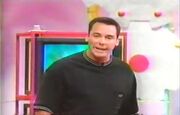
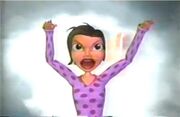
- On February 5, CBS announces Wheel of Fortune 2000 as part of an overhauled Saturday-morning lineup for the Fall (designed to comply with the FCC's then-new E/I regulations). Jon Mandel, senior vice president of Grey Advertising, states that "People will trash it as silly, but Wheel of Fortune may be the sleeper of the season."
- At least two pilots are recorded in early or mid-July, with only one known difference from the series: if a player lands on The Creature with no points, s/he is "eaten" out until their next turn. It is likely that these were aired as part of the series.
- A publicity shot of Sidoni at the Wheel shows a normal 750 wedge in the position of www.Wheel2000.com. As this appeared in a TV Guide article on the show's debut, it is likely to be from the pilot tapings.
- Double Up is likely not present, as several episodes of the series have shots of a regular 500 in its position.
- On August 11, Tanika is announced as Cyber Lucy.
- On August 29, David is announced as the show's host.
September 1997: (show begins September 13)
- On September 13 (Marissa/Gerrard/Vinnie):
- David enters from the door closer to the Wheel.
- During Round 1, Marissa tries to pick up the Prize Box right after landing on it (as was the case from 1983-90), but is stopped by David. She ends up claiming the prize, a Game.com, which is merely referred to as "a personal video game system". She later becomes the first aired winner of two Prize Boxes (Rounds 1 and 3).
- Gerrard solves the Round 2 puzzle PRINTING PRESS with just the R's, E, and S's showing; the round is played only by him.
- On September 20 (Jessica/Lea/Dwayne):
- The front of Lucy's hair is bleached. She and David discuss the hairstyle before the start of the game.
- Round 1 is a ten-letter word.
- The game starts with a null cycle edited out. This is indicated by Dwayne's arrow being on The Creature instead of Jessica's when Jessica makes the first aired spin (every game starts with the red arrow pointing at the center of The Creature) as well as David and Lucy continually commenting on The Creature while the Wheel is spinning and when David shouts, "Not again!" when the spin lands on The Creature.
- The Creature is landed on twice more in Round 1, the first of these occurrences by Lea and the second by Jessica. Afterwards, David and Lucy shout, "No more Creatures!" Coincidentally, The Creature is avoided for the rest of the game.
- Lea gets two Prize Boxes in the first two rounds. She is nicknamed "Prize Box Girl" by Lucy ("Prize Box Lady" by David) when she lands on it the second time.
- At the start of Round 3, Lucy notes that Word Rap is her favorite category. As a possible result, Dwayne chooses it.
- On September 27 (Sara/Ian/Jay):
- Lucy is wearing "green and green" as quoted by David.
- Sara solves Round 2 for 200 points, which is bumped up to 500.
- On an episode sometime during the show's run, David notes that Lucy always dances when Globetrotter is chosen.
- On another episode (Nick/Tissan/Christine):
- Round 1's puzzle is a ten-letter word. When all the consonants are revealed, Christine, with 250 points, buys an I which is in the puzzle, but is unable to solve it afterwards. Nick then buys an A, which is also in the puzzle, then solves it for 500 points.
- In Round 2, Tissan gets a Prize Box, which has a Game.com. He then has difficulty putting the prize back in the box before setting it down beside him and spinning again. Lucy says of this, "I would have put it in my pocket."
- Nick solves the Round 3 puzzle (while in Speed-Up) for 2,300 points instead of choosing a letter upon regaining the turn.
- Nick sweeps the game. During the Bonus Round, he chooses an L as one of his letter choices. Although this is held against him, he is still able to solve the puzzle for a Limo Ride. After recapping all the prizes for Nick, David says, "We have no prizes left. Nick took everything today!"
- On yet another episode (Natalia/Julia/Carl):
- The Final Spin lands on Double Up. As a result, each consonant is worth 500 points.
- Julia sweeps the game and wins a computer in the Bonus Round.
- On yet even another episode (Alyssa/Nicole/Simon):
- Simon solves Round 2 for 100 points after choosing the puzzle's final correct consonant on the Prize Box. The score is brought up to 500.
- Nicole solves Round 3 for 500 points. As a result, the game ends in a tie for the only known time. Simon solves the tie-breaker round for 15,000 points, which is also the only known time that a contestant accumulates a five-digit score. Simon goes on to win a computer in the Bonus Round.
October 1997:
- By October 3, David begins a tour of Wheel 2000, sponsored by Bravo Card and branded by Discover, to various shopping malls in Chicago, Philadelphia, Pittsburgh, Washington D.C., New York City, Charlotte, Dallas, Denver, Salt Lake City, Seattle, San Jose, and Anaheim.
- The format is the same, except the Wheel has only 14 wedges including 850 (its first appearance since 1979), Bravo (much like the Prize Box, awarding a small prize package including the 1995 handheld game), Alientoss (the stunt wedge), and a very different design for The Creature. All the point values end in 50 (150-850) except the top values of 1,000 and 2,000. The sound effect for the Alientoss wedge is the same one used when Double Up is landed on. The sound effect used for both the Bravo and 2,000-point spaces is the same as the one used when the Prize Box is landed on. The Wheel is angled forward for better visibility from the audience.
- The puzzle board consists of trilons in an 8×3 fashion. As a result, the category is announced without the players choosing one. The sound effect for correct letters is the same as when a Double Up question is answered correctly.
- Winners receive a four-night, five-day trip to Universal Studios in Hollywood, Florida, where they will attend a taping of Wheel 2000.
- On October 4 (Katie/Seph/Brent):
- David enters from the door closer to the Wheel.
- Brent calls the last consonant in the Speed-Up puzzle GOOSE BUMPS, but nothing signifies that only vowels remain (specifically the O's, E, and U) until after Katie picks D, at which point Lucy says "There's only vowels left, I believe." Seph then calls the O's and solves the puzzle. The error causes Brent to win, as Katie had enough to overtake him.
- On October 11 (Lauren/Skye/Murphibennett):
- David enters from the door closer to the Wheel.
- Three vowels are bought in Round 2, but none of them are in the puzzle.
- The physical game, Letter Launch, is not played.
- Murphibennett sweeps the game, but fails to solve the bonus puzzle SOCRATES with the O and A missing.
- October 18 (Gino/Alana/Jason) is believed to be the third taped episode as, while retaining many elements of the first two tapings (see "December 1997" for more), it has the regular Wheel layout and no stunt replaces the one present in Round 1. On this episode:
- Monumental makes its only known appearance. It is never chosen.
- No puzzle-solve cue is used in Round 1, and the subsequent explanation of NAPOLEON (Bonaparte) does not have any accompanying pictures.
- Jason loses 2,250 points to The Creature in Round 2, which may be a record.
- The explanation for the Round 2 puzzle TOM SAWYER is a pretaped message clearly intended for a puzzle of MARK TWAIN, as Tom Sawyer is never actually mentioned.
- Eleven wrong letters are called in a row in Round 3 (ORBIT) with the R and T showing, with all but the first occurring in Speed-Up.
- Later in the Speed-Up, Alana calls the last consonant but does not solve. Immediately afterward, a series of high-pitched beeps is used to denote "only vowels remain", after which Jason calls the O and solves. It is not known if the "only vowels remain" beeps were used on any other tapings in the Speed-Up, although the October 4 show did not.
November 1997:
- On November 1 (Dawnell/Ebony/Patrick):
- David enters from the door closer to the Wheel.
- Patrick mentions that "I'm ready to play Wheel of Fortune!", which appropriately segues into David's gameplay spiel.
- The first spins of Rounds 2 and 3 suddenly jump from approaching the Prize Box to just passing it. This may indicate that a "null" cycle was edited out, which appears to have been the case on at least one other episode.
- With only vowels remaining in the Round 2 puzzle INTESTINE, Patrick buys an A. Play passes to Dawnell, who has no points and no guess, getting buzzed out. Play then goes to Ebony, who buys the E's and mis-solves the puzzle (now with only the I's missing) as ANTESTONE. Patrick then solves correctly for 2,000 points.
- During the Speed-Up round, Ebony tries to call two letters in a row.
- Patrick sweeps the game with a possible record maingame score (besides tie-breakers) of 5,400 points and wins a computer in the Bonus Round.
- By November 1 (or, rather, this point in taping), the A-B envelope colors are swapped to have red letters on a yellow backing. Jay/Sara/Ian also uses this color scheme.
December 1997:
- The first taped episode (Gregory/Kayce/Jeremy) likely airs in December or January, containing a bevy of differences:
- David walks out of the door farther from the Wheel and converses with Lucy for a bit.
- The set piece between the red and yellow contestants is a clock with the hands pointing to approximately 11:50. The time changes as the episode progresses, giving a likely reason for its removal: namely, that the episode takes about two hours to record.
- The rules are explained slightly differently, with the camera zooming out from the center to show the Wheel, then cutting to the special wedges as David points them out. The only special space that gets a zoom effect is The Creature.
- The Wheel is a bit looser, and its layout is slightly different (with a noticeable pattern of indigo/black, blue, red, yellow, orange, pink, and green throughout): 250 and 700 are swapped, as are www.Wheel2000.com and 450. The former was probably changed to not have two adjacent 250 wedges, while the latter was likely to not have three special spaces in a row (the top value and double-width stunt wedge being the others). For Round 2, 700 is put between two 250-point spaces.
- The top value space has no glitter lining usually seen on most of the other episodes.
- None of the monitors show the Wheel 2000 logo.
- The large "turn indicator" lights to the left of the contestant displays are not present, and the flippers are a bit longer. (It is known that at least one other episode did not have the lights.)
- The contestant solve insert is in the upper right-hand corner.
- A new stunt is added for Round 2: Cube Roll (the stunt in Round 1 is Smell-O-Letter).
- On the first taped episode:
- The clock behind the players is at approximately 11:58 when a Smell-O-Letter wedge is hit, which is roughly consistent with the clock when it is first seen; when the stunt ends two minutes later, the clock is at approximately 12:25.
- At the beginning of Round 2, the clock has jumped from about 12:30 to about 12:50. Later in the same round, the clock jumps to about 1:05 and the Cube Roll game (which had not been played yet) is gone from the double-width wedges; it is very likely that at least one null cycle (including the stunt game) was edited out.
- When the Round 2 puzzle is solved, the clock is at about 1:05. When David begins recapping the scores, it jumps to 1:30.
- Lucy sits on top of the puzzle during Round 1; one called letter ends up being the one she is sitting on, obscured by her legs.
- The game ends after two rounds, a very likely record low for the American franchise; Turkey's adult version is likely the only international version to beat this with only one round and the bonus round.
- There is a noticeable edit right after David consoles the player after the Bonus Round and before his signoff. Afterward, Lucy's fee plugs are spoken in a somewhat different tone.
- David dances with the Bonus Round player during the credits.
- The clock behind the players is at approximately 11:58 when a Smell-O-Letter wedge is hit, which is roughly consistent with the clock when it is first seen; when the stunt ends two minutes later, the clock is at approximately 12:25.
- On at least two episodes (the above and Erin/Caleb/Nikki), for the only known time since October 1987, a commercial break occurs mid-round: Round 1 on the former, Round 2 on the latter. The former appears to have been inserted in post-production, as Gregory's score display is blank despite having had 1,600 a few seconds earlier; the clock has also jumped. (The intro afterward appears to have been done in the same manner.)
- On Erin/Caleb/Nikki:
- Only two rounds are played.
- Nikki lands on Double-Up once in each round, answering both questions correctly. After the aforementioned mid-round commercial break, however, the Double-Up is replaced by a regular 500-point space, possibly due to the Final Spin occurring soon after.
- Caleb sweeps the game.
- The bonus puzzle EINSTEIN is one of only three known instances of RSTLNE revealing every consonant in a bonus puzzle.
- Caleb fills in the above bonus puzzle completely and wins a blimp ride.
- As there are some similarities with the first taped episode, such as the mid-round commercial break, the presence of the clock and the absence of turn indicator lights and the top values' glittery outlines, it's possible that this may have been the second taped episode.
- On another episode around this point (Alberto/Sarah/Camille), Alberto sweeps the game and wins a computer in the Bonus Round. He solves the bonus puzzle DENMARK despite getting no help from his extra letters.
January 1998:
- On January 8, CBS announces the overhaul of its weekend schedule for the 1998-99 season, replacing everything (including Wheel, the long-running Beakman's World, and The Weird Al Show) with new cartoons from Nelvana and Scottish Television (Anatole, Mythic Warriors, Birdz, and Flying Rhino Junior High).
February 1998: (show ends February 7)
- At some point in the show's history, a contestant who loses their Bonus Round asks David why the prize was not revealed, and David explains that the prize is only shown if it is won.
- February 7 is the last episode with 100, 150, 200, 650, 750, and 2,000 as Wheel values, although $2,000 returns for the Season 22 opening animation and $650 returns to gameplay in Season 30. It may also be the last taped episode.
- Repeats air until September 26, when it is removed from CBS' schedule; it is known that the premiere reran February 14.
- The website remains accessible through at least October 13, 1999. Sometime between then and May 10, 2000, "www.wheeloffortune2000.com" redirects to GSN; sometime between March 9, 2001 and November 28, 2003, it begins redirecting to various generic search engines.
- Repeats continue on GSN until October 2001, airing in various slots before moving to 4:30 AM Fridays as part of GSN's "Cable in the Classroom" hour; reruns then air on Discovery Kids Canada for a time.
Links[]
- Official website (latest revision available via Archive.org)

